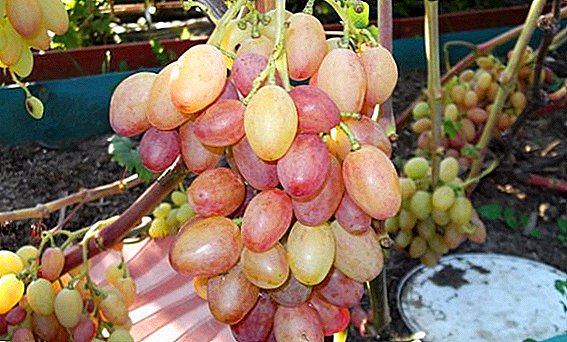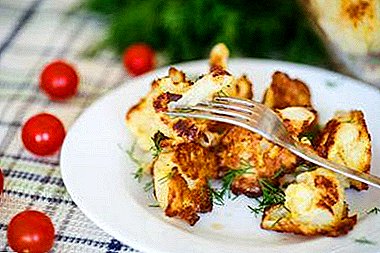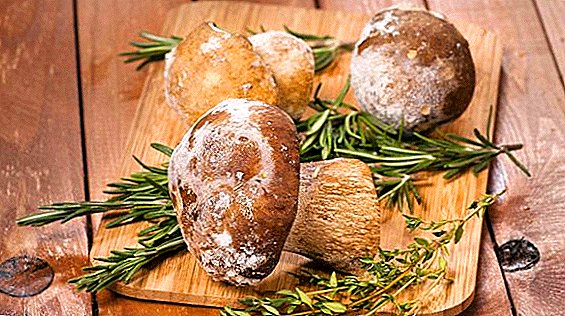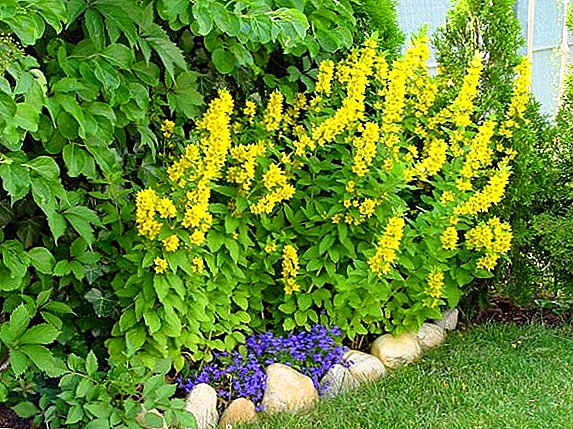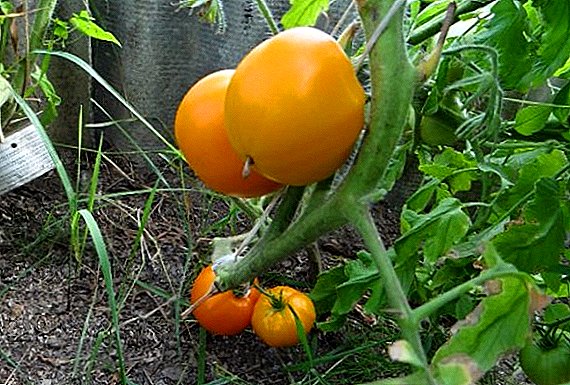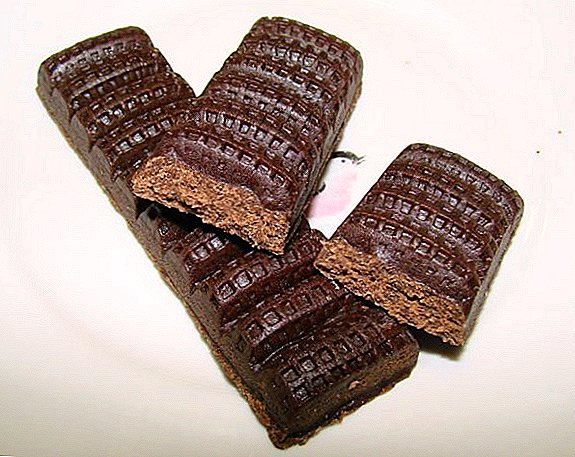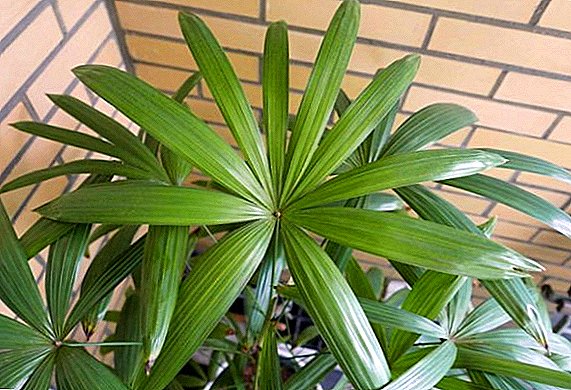 Beautiful rapis is able to revive any room, emphasize its depth and visually expand the space. The tropical plant is completely unpretentious in its care, easily adapts to the microclimate of offices, shopping centers and ordinary apartments. In this article we will talk in detail about the rules of care for rapis, we will talk about the methods of its reproduction and methods of pest and disease control.
Beautiful rapis is able to revive any room, emphasize its depth and visually expand the space. The tropical plant is completely unpretentious in its care, easily adapts to the microclimate of offices, shopping centers and ordinary apartments. In this article we will talk in detail about the rules of care for rapis, we will talk about the methods of its reproduction and methods of pest and disease control.
Rapis: botanical description
In the natural habitat of the palm tree rapis is found in China and Japan. In the people, this plant is called palm tree or stick palm.
In some countries, where the decorative beauty of rapis is deeply appreciated, you can hear another everyday name - lady's palm. This name appeared because of the long beautiful leaves, slightly beveled at the tips.
Important! In winter, watering a rape is necessary every 10-12 days. More frequent watering will lead to putrid processes in the root system.According to botanical data, there are about 15 types of rapes, but only 2 species are of decorative value - high and low rapes.
Asian beauty in appearance is very similar to bamboo, as it has a low even stems. They are covered with mesh fibers. Under optimal microclimate conditions, the stick palm will begin to bloom flowers, the shade of which is very close to ivory coloring.
After a period of flowering spherical fruits appear that are not suitable for human consumption. Rapis has a powerful growing root system. Over time, the plant begins to multiply independently by root offspring, because of which a shrub is formed.
Kinds
Not long ago, only low rape was used for home floriculture, which is compact in size and unpretentious in its care. But with the advent of large shopping centers and huge offices, high rapes became popular, which gives any room a slightly exotic look and gives a feeling of peace of mind.
Tall
Lignified bamboo-like shoots of this plant reach a height of 3 meters. Rapis tall has dark green leaves, divided into 5-10 shares. The length of the leaves is 25-30 cm, width - 5 cm. It has thin petioles at the base of the fibers. When grown in a home decorative design active bloom is not observed. Perhaps this is due to the lack of natural substances for the palm tree in the microclimate of the premises.
When grown in a home decorative design active bloom is not observed. Perhaps this is due to the lack of natural substances for the palm tree in the microclimate of the premises.
Low
This type of palm is most common in the home interior, since the height of its shoots does not exceed 150 cm. The plant is bush-shaped, with deeply dissected leaves. The leaves are hard, glossy, about 20-25 cm long.
When creating optimal conditions in the room there is the likelihood of flowering of this type of paper. 
The best conditions for the plant
If you want to preserve the true decorative beauty of a bamboo palm, then you should create an acceptable microclimate for it.
Lighting
A stick palm tree in a natural habitat is used to being in a constantly lit place. Such light-loving characteristic of many representatives of palm plants of Asian origin.
It is best to place the shrub near the western or eastern windows. However, unlike many other types of ornamental palm trees, rapises are able to withstand penumbra, so they can be placed near the northern windows or localized in the heart of the interior.
But long-term exposure to direct sunlight can burn delicate leaves of the bush.
Did you know? Since ancient times, palm plants were considered symbols of victory and peace. In some nations, the winners were given wreaths of palm leaves.The plant does not need additional light in the winter. Shrubs have enough natural daylight, even if the length of daylight does not exceed 8 hours.
 But, despite this, the palm must be rotated regularly, so that different parts of the crown alternately under a direct source of light. If you do not do this, you can lose the uniform decorative beauty of the Asian miracle.
But, despite this, the palm must be rotated regularly, so that different parts of the crown alternately under a direct source of light. If you do not do this, you can lose the uniform decorative beauty of the Asian miracle.Find out which plants are best to keep in the office, nurseries, bedrooms, on balconies.
Temperature
Bamboo palm adapts very well to the temperature of the surrounding microclimate. Unlike some types of fascinating South American flowers, rapis will not lose its decorative effect if it is maintained at a temperature of + 10 ° C in winter.
The most comfortable temperature regime during the resting period of the shrub is + 12 ... +16 ° С. But the Asian plant is accustomed to adapt to new growing conditions and will not die even at very low temperatures, but it may lose its decorative effect.
In summer, the rapis will be able to show itself in all its glory at temperatures of + 20 ... +25 ° С. If the figures will slightly exceed the norm, then you should take care of optimal humidity and regular airing of the room.
In general, these palm trees are very fond of airing, especially on hot summer days. But make sure that strong drafts do not penetrate your home, because they can harm the bushes.  In summer, rapis is best carried on an open balcony, terrace, flower bed or in a company with other exotic excreta. Outdoors shrubs will be in optimal conditions, perhaps even please you with its flowering.
In summer, rapis is best carried on an open balcony, terrace, flower bed or in a company with other exotic excreta. Outdoors shrubs will be in optimal conditions, perhaps even please you with its flowering.
If there is still no rain on hot days, the palm must be sprayed with clean water. Indoors at temperatures above +25 ° C spraying is also a mandatory procedure for increasing the humidity of the air. In the rest of the year, rapis can grow without any problems in a room with dry air masses.
How to care for indoor rape
Watering, fertilizing and timely pruning are important aspects of caring for shrubs. If you ignore the plant, forget about watering and dressing, then diseases can occur that can lead to the death of an Asian miracle.
Watering features
Watering shrubs in the summer should be regularly, to prevent drying out of the soil. Watering should be abundant, it is necessary that the soil is saturated with water throughout the volume (water until water starts to flow out of the holes in the pan).
In winter, the frequency of watering is reduced, but not due to the fact that the plant is at rest. It is just that the air is cooler in winter, so the evaporation of liquid from the soil is a little slower. 
Important! At too fast blooming of young leaves, the lower part of the palm tree suffers from an excess of moisture. In this case, the shrub must be removed from the pot and process its roots with wood ash. Then transplant rapis in a new substrate.The temperature of the liquid for irrigation should vary within + 20 ... +23 ° С. It should not be stiff and cold. It should not be irrigated with water from the tap, as tap water has a high rigidity. The irrigation material must be separated and light, without heavy elements in it.
Proper feeding
It is necessary to feed rapis from the beginning of March to the middle of autumn. In winter, the palm tree does not need fertilizers and fertilizers. Ready-made complexes can be used as fertilizers: Florovit, Bon Forte, Mr. Tsvet. Palma, etc.
Find out why you need nitrogen, potash, phosphate fertilizers.During this period, fertilizers must be applied every 2 weeks in the proportions determined by the manufacturer on the package.

Do I need trimming
The processes of pruning old leaves and shoots can begin in March. It is at the beginning of spring that the shrub needs to be rejuvenated: remove all old, fading and yellowed leaves. Re-pruning should be done as needed.
But you should remember that watering and spraying a palm tree after trimming is prohibited, as moisture can get inside the trunk and provoke the processes of decay.
What to do with the plant after purchase
Immediately after the purchase, the plant needs some time to adapt to the new room and microclimate. This period is called quarantine. In the quarantine period rapis must be placed in penumbra (7-10 days).
After that, the shrub can be put on a sunny place for 5-7 days. Only after such procedures can the quarantine be considered closed, and the plant during this period is fully adapted to the new microclimate. 
Do I need a transplant
Only palm trees whose roots have begun to pass through the holes in the bottom of the pot need to be transplanted. If in this case the transplant is not carried out, then the plant may die due to the impossibility of growth and lack of soil space and useful minerals.
But if you buy a small palm tree in a huge pot, where the root system feels comfortable, then you can forget about transplanting until the plant reaches its maximum size.
It is important to understand that if after the purchase the transplant is still necessary, then in any case it should be postponed for 2-3 weeks. This period is necessary for adaptation, without which the plant can not endure the difficulties of transplantation.
Learn more about the properties of perlite, vermiculite, coconut substrate, peat, compost.
Transplant rules
When selecting a substrate for rapis, special attention should be paid not only to the composition, but also to the reaction of the soil. It must be slightly acidic or at least neutral. For this Asian shrub it is best to use ready-made purchased substrates (for palm trees).
If you are going to independently create a substrate, then its formula should be as follows: turf, peat, compost soil and river sand in proportions of 2: 2: 2: 1. 
Did you know? The largest leaves on our planet has just a palm plant. Raffia palm leaves have a length of 20 meters!Replace rapis should be only as needed. Palm transports annual transplants poorly, so try to minimize such procedures. Transplantation should be carried out only with the presence of an existing earthen coma on the root system of the shrub. To bare the roots is dangerous, since even a small damage to the roots can lead to the death of the plant.
The transplanting pot should be wide, but not very deep. Too deep a capacity provokes stagnation of moisture, resulting in impaired breathability, and the root system is subject to enormous loads.
In a new pot for transplanting should be equipped with good drainage. Moreover, pebbles for such a procedure is not suitable, it is best to use fine gravel or expanded clay. For better breathability, a hydrogel or sphagnum moss can be added to the substrate.
Transplantation is best done in the spring, and immediately after it is finished, give the shrub 2-3 weeks quarantine: air the room regularly, spray the leaves with water, water it regularly and do not forget about fertilizers.
How to propagate raps at home
There are three main ways of breeding rape:
- offspring;
- sowing seeds;
- separation of the root system of the mother plant.
 The latter method is the most popular. In order to realize it, it is necessary to separate one shoot of the plant along with the root (carefully, so as not to damage the main part of the root system). The separated shoot should be transplanted into the soil, the composition of which is described above. And do not forget that transplant is best done in the spring, a few weeks after the anti-aging pruning.
The latter method is the most popular. In order to realize it, it is necessary to separate one shoot of the plant along with the root (carefully, so as not to damage the main part of the root system). The separated shoot should be transplanted into the soil, the composition of which is described above. And do not forget that transplant is best done in the spring, a few weeks after the anti-aging pruning.Learn how to deal with diseases and pests of palm trees.
Fight against diseases and pests
A stick palm tree, like other indoor plants, can be exposed to various diseases that appear along with pests. Under certain microclimate conditions, harmful insects can attack a shrub. If the disease does overtake your palm, then you need to know how to overcome it.
Consider the most characteristic pests of rapis, and also tell you about the methods of dealing with them:
- The leaves begin to turn yellow and dry, the bush slowly fades. This may be the first sign of the appearance of shield on your houseplant. Carefully inspect the lower part of the leaves, where you can see these small insects. You can fight them with the help of chemicals - insecticides. You can use traditional methods and wipe the leaves with cotton wool previously soaked in tobacco infusion.

- If a spiderweb appears on the shoots and leaves of a rapis, then most likely your spider mite attacked your palm. It affects plants that grow in dry and hot microclimate. That is why always monitor the humidity of the air in the room. To overcome the spider mite can be insecticides, which are sold in flower shops.
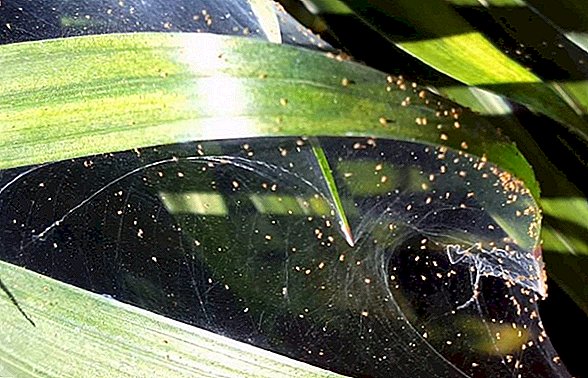
- The felts infect the palm shrub very rarely, but the probability of hitting is different from zero. The presence of felt can be found on the white fluffy lumps at the base of the leaves. These lumps must be removed immediately with a toothpick and then treated with rape insecticidal solutions.

Important! An adult rapis is best not to replant, since the plant can not withstand such loads and die.Remember that sudden changes in the microclimate can negatively affect the decorative qualities of the paper. It is not always the pests that become the main problem of the fading beauty of the Asian miracle.
Room rape: possible problems when growing
If you are the owner of a room rape, then you should know that under the wrong conditions of detention and a poor microclimate, the palm tree may become unwell:
- If the shoots do not grow to the desired height and the tips of the leaves dry up a little, then you need to measure the humidity of the air in the room and bring it back to normal.
- The leaves fall, wither, blotch appears on them - all this is a consequence of insufficient watering of the shrub. It may be in too hot a microclimate.
- If the leaves wither and darken, then the palm begins to freeze. Transfer it to a warmer room, and in 7-10 days all its vital functions will return to normal.
- If small and large spots of yellow color appear on the leaves, it is better to move the rapis away from the sun's rays.
- With insufficient feeding, the shrub may slowly grow, its shoots may not reach a height of even 1 meter. To correct the situation fertilize the plant.
- If young leaves begin to unfold ahead of time, then reduce the intensity of irrigation in winter, as the root system is exposed to severe depletion (if ignored, rotting processes can begin).
- Lower leaves may begin to fall off with age. This is a natural process.
The common problems of indoor plants include damage caused by thrips, aphids, whitefly, nematodes, powdery mildew, root rot, chlorosis.

Other palm
In addition to rapis, popular palm indoor plants remain: hamedorea, dipsis, date palmate, coconut nut-bearing, pandanus and others.
Learn more about how to care for hamedorrhea, date palm, yucca, hovey Foster, Belmore, cicasus, chrysalidocarpus, pandanus, dracaena, pachypodium, cordilina at home.
Hamedorea
Hamedorea is characterized by beautiful feathery leaves, small size and slow growth. At home, it almost does not bloom, but if such a miracle happens, the owner can contemplate the small velvety flowers of sunny yellow color. In the natural habitat, hamedorea is found in the tropical forests of Central and South America.
Dipsis
Under natural conditions it grows in tropical forests of Asia, Central and South America. In the wild, some varieties grow to 10 m, in home decorative culture - up to 3-5 meters. Dipsis has smooth greenish stems and long pinnate leaves. 
These are the rules for taking care of raps at home. This Asian palm tree is not particularly fastidious, but if it creates the right conditions in the room, then it will delight you with its decoration all year round.





